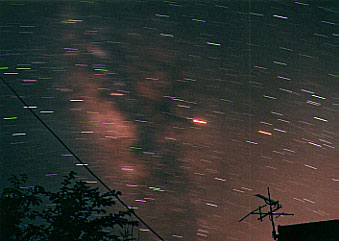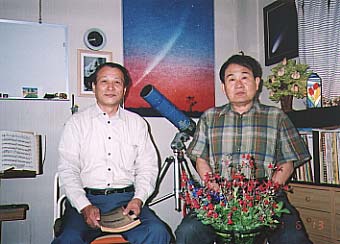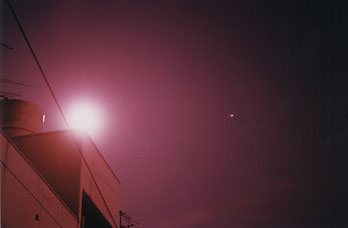
| Return |
| • June 30 This is the Wanuke God festival day. They say it always rains on the festival day, partly because it is in the middle of the rainy season. In fact, in the past half century there have been only about 5 rain-less days on record. However, today it has started clearing up in the afternoon and I am preparing to go to the observatory. Nearly 30 years ago, the day our oldest daughter Satoko was born, I went to the nearby shrine of a guardian god taking the little oldest son along. When we crossed the bridge over Kagamigawa River to the south and the shrine's forest came into view, we heard frogs croaking nosily in the rice paddies along with the festival music from the shrine. During the festival, good old gas lamps were burning, numerous revolving lanterns turning endlessly, and visitors in summer kimono enjoying the festivity scenes. Today, however, there is nothing exciting about the festival; no popular sumo wrestling, no smell of gas, just ordinary stalls lined up along the path. No festive atmosphere exists any more. I miss those frightening cries of goblins I heard while walking along narrow lanes between paddy fields on my way home. It was the year when Comet Suzuki-Sato-Seki was discovered. It was found over the forest of Ishitate Hachimangu Shrine, while I was searching from my home. • June 26 |
 LINEAR C/2001 A2 moving north |
| • June 25 The sun has peeked through the clouds after many days of poor weather conditions. It was extremely hot during daytime with a 33°C mid-day temperature. I went to the observatory and found it like a steam bath inside the dome. It has been a very humid, unpleasant day. Mars, which made the closest approach on June 22, is now in retrograde motion, getting closer to Antares again. Mars seen from Geisei is more like a brass color than red. It is because the air over Geisei is clearer than in the urban areas. Mars seen from Kochi City where I live is always ruddy like a intoxicated person's face. Mars photographed at Geisei is also far brighter than Antares. |
 The Milky Way, Mars, and Antares At about 23.00, June 25 Camera: Nikon F2, 35mm f/2 lens, ISO 200 film |
| • June 23 The weather has not improved much. Light rain has been falling throughout the day. There has been no interesting star-related news and boring days continue. From now to mid-summer it will be the right season for telling children horror stories. When I was a child, "comet-like ghosts" called "hitodama" (ignius fatuus) with a short tail often appeared in the countryside. Even in Kochi City we sometimes saw bluish balls of fire (called a fox fire) in the north. On the summer evenings we brought out a bench to cool off. Neighbors in summer kimono gathered around and listened to the elders' old tales. While story-telling is going on, a lone mysterious blue light appears on the hillside in the north. Before long it flies off and land on the side of another mountain, then disappears. As soon as the light goes out, another appears on the same spot and moves across the hillside. Are the "fox fires" playing hide-and-seek? However, roads and houses have been built since around Shorinji, where we often spotted the mysterious lights. Even a golf course was developed there and the fox fires disappeared soon. In old days, Kamimachi, where I lived, didn't have many homes. Even a pond was there. On summer evenings, when it was raining silently, ghosts appeared. Their cries were heard from nowhere and I now sort of miss them. Tomorrow I will tell you a ghost story around Geisei Observatory. • June 18 |
 Mr. Keiichiro Okamura with the children at the observatory |
| • June 16 Inclement weather has been continuing. While it was still raining, the forecast issued by the weather bureau was that it would clear up in the afternoon on June 14. Contrary to that forecast, the weather was unsettling during the morning, then it turned rainy in the afternoon. The forecast for today June 16 was "fine" but the sun appeared only early in the morning. The afternoon and evening skies were overcast with dark clouds. Satellite images from Himawari (a Japanese meteorological satellite) show the whole of western Japan is clear of clouds. But moist air flows to Shikoku from the south generate low-level clouds locally and cause rainfalls when the moist air is forced against the Shikoku Mountains. In old days the elders used to say "when the clouds are moving northward, it rains; when they are moving southward, it will be fine." This was a forecasting method when weather forecasting was not fully developed during the Meiji Period. I, too, predict the next day weather from the direction of the cloud movement. The forecast for yesterday was "fine", while the clouds were moving north slowly. It surely rained! The present day weather forecasting supposed to be based on modern science was no match for the ancient technique of forecasting. Not only in Kochi Prefecture, but in many areas of Japan, fishermen predicted weather from wind and cloud directions quite accurately. Their knowledge and wisdom haven't been taken up by successive generations and been lost forever. • June 13 |
 With Mr. Takao Namura (left) |
| • June 9 I received a copy of my very first book "Seeking Unknown Stars" from Mr. Eiichi Ikegami, a friend of mine living in Yamaguchi Prefecture. He has been a fan of me and come to see me twice. Mr. Ikegami bought the book as soon as it was published in 1966 and still keeps it with great care. I have no copy of the book myself. If you can find this "non-existent" book at a second-hand bookshop, it will be a miracle. I know that many people are looking for a copy of the first printing of this book. The launching of this book was held at Fairmond Hotel at Chidorigafuchi, Tokyo in May 1966. The moving experience of the ceremony, my book firmly held in my hand, returned to me with great intensity. I am deeply grateful to the then young readers who loved my book as if it were a bible for life. |
 |
| • June 8 When I looked out the window of my study toward the south at midnight, a 16-day-old moon was due south with Mars to the west. In spite of little thin clouds, Mars was seen clearly. Mars will get closest to the earth on the 22nd of this month. Its ruddy color will be awesome in Geisei's transparent sky. This afternoon I went to a community hall in Kochi City and gave a talk to students of "Women's Class." Mars' current close approach was the main topic. Unlike junior and senior high school students, adult audiences would listen to you attentively and you would become more enthusiastic. Whether the lecturer gives his best or not depends on the audience attitude. The weather has been gorgeous since this morning. Have they declared the end of the rainy season prematurely? You wouldn't have this fine weather during a break in the rainy season. I hope the weather will be fine like today when LINEAR C/2001 A2 appears in the second half of the month. |
 Moon and Mars |
| • June 7 At last the rainy season has arrived. It has been rainy for the past three days, but it started to improve last night with the full moon appearing occasionally between thick clouds. It has been clear since this morning. On fine days in June forests and mountains look particularly beautiful. In the afternoon I went to the sports park at Haruno-cho. It is well known for Hydrangea. Vivid blue of hydrangea was very refreshing. I swam about 600 meters in a 50m outdoor swimming pool for the first time this year. The water temperature was about 10ーC and it was biting cold. What is C/2001 A2 like now? As predicted by IAU, will it brighten to 4th magnitude in the early morning sky in mid-June? While swimming, I worried about the weather and without thinking switched to breaststroke to look up at the sky. |
Copyright (C) 2001 Tsutomu Seki.